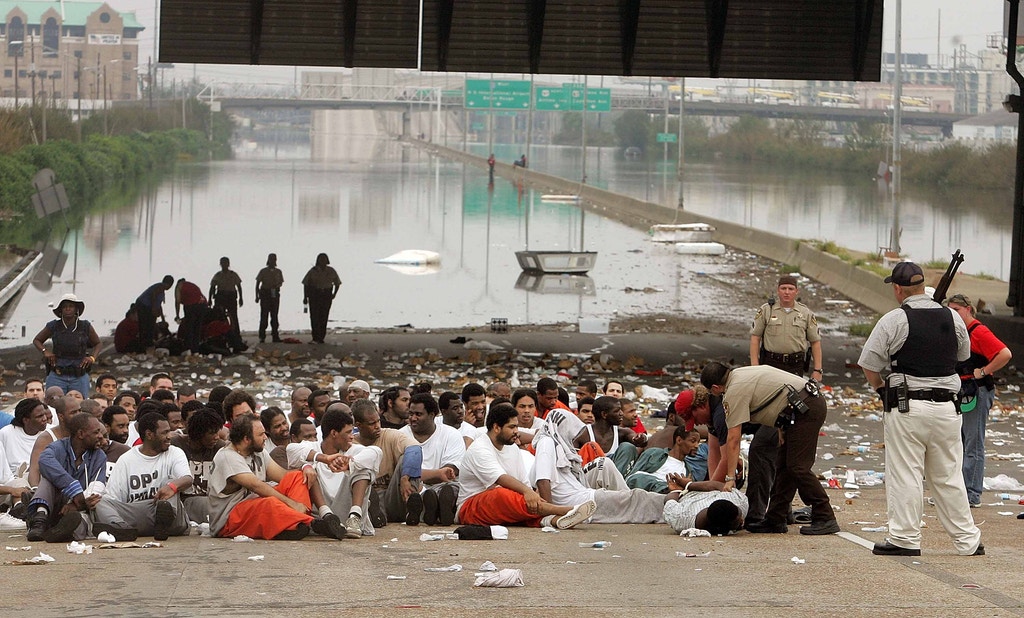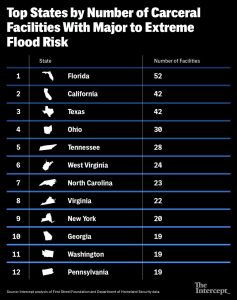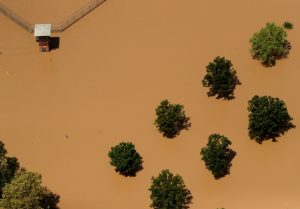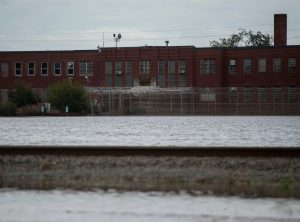by Alleen Brown / The Intercept

Police watch over prisoners from the Orleans Parish Prison who were evacuated due to high water in New Orleans on Sept. 1, 2005. Photo: Mario Tama/Getty Images
THE FLOODING IN Dixie County, Florida, began in July, brought on by Tropical Storm Elsa. Then the rains kept falling. By August, the ground was saturated, and the semirural county was underwater.
At the Cross City Correctional Institution, the prison administration repeatedly canceled visitation hours throughout July. As August progressed, the yard between buildings filled with water. Classes and religious services were scrapped.
On the main unit, fetid water started coming up through the drains, said DaRon Jones, who is incarcerated at Cross City. Guards told all the prisoners to pack what they could into a pillowcase and prepare to evacuate, but Jones spent hours locked in his cell with the filth. “The water was close to ankle-deep, with human waste floating by as we were fed in our cells,” he said. “The smell was unlike anything I have ever encountered.”
When they were finally led outside, Jones waded through knee-deep water. “There were snakes and bugs swimming in the water as we made our way to the bus,” he recalled.
The rising waters were predictable, according to an Intercept analysis that cross-referenced flood risk data from the First Street Foundation with the locations of more than 6,500 carceral facilities across the U.S. Cross City was at a severe risk of flooding.
FIERCER HURRICANES, rising seas, profuse rainfalls: The climate crisis is causing more flooding across the nation. And while federal and state institutions are generally lagging when it comes to climate resilience, the carceral system is in particular peril. Many jails and prisons were built as the war on drugs ramped up and have since been all but neglected. Worsening disasters will test the deteriorating buildings.
“Most of the infrastructure we have now was built in 1980s and 1990s,” said Molly Gill, vice president of policy for FAMM, an organization focused on sentencing reform. “We built all these prisons when we passed mandatory sentencing laws and had our prison booms and embarked on mass incarceration,” she said. “All those chickens are coming home to roost.”
Florida is in especially bad shape. Cross City is one of 52 jails, prisons, and detention centers in the state that face major to extreme flood risks over the next 30 years, according to The Intercept’s analysis. Half of those facilities, including Cross City, are run by the state of Florida, under the administration of Gov. Ron DeSantis. The state is responsible for more carceral institutions with elevated chances of flooding than any other government authority, local or national.
The DeSantis administration seems ill-prepared for the next rounds of flooding. There is a huge maintenance backlog, little evidence of robust disaster planning, and resistance to policy changes that would leave fewer people in prison. For state leaders, staffing woes overshadow all those issues: Some 5,500 low-paying prison guard positions are currently unfilled, out of a workforce of 18,000.
Authorities with the DeSantis administration said the prison system is addressing problems like flooding. “Planning and preparing for natural disasters such as flooding is an integral part of our operations. We will continue to work with local emergency management officials in an effort to identify aggravators associated with the rise in flood waters,” Molly Best, deputy communications director for the Florida Department of Corrections, said in an email. She defended the department’s response to the Dixie County flooding: “Inmates at Cross City CI did not wait weeks for evacuation. Cross City CI was evacuated immediately at the onset of the flooding incident.”
Prisoners, as wards of the state, can’t make decisions about leaving flood zones. For the most part, they must rely on their custodians — policymakers and politicians — to protect them. DeSantis has persistently refused to pursue reforms that would meaningfully improve conditions, and in the state government, there is little will to hold him to account. Incarcerated populations tend to be low priorities in the halls of power.
“Most legislators would much rather focus on jobs and education in Florida than they would trying to fix the most difficult public policy area in the state, which is a collapsing prison system, because there’s no credit to be gotten from that,” said Republican state Sen. Jeff Brandes. “We are on a completely unsustainable trajectory.”IN ORDER TO get an idea of which carceral facilities could suffer from floods, The Intercept mapped a flood risk database against the Department of Homeland Security’s 2020 register of jails, prisons, Immigration and Customs Enforcement holding facilities, and juvenile detention centers.
The flood risk data was drawn from the First Street Foundation’s flood model, which was developed as an alternative to the Federal Emergency Management Agency’s outdated and incomplete flood zone maps. First Street’s property-specific flood risk assessments, or “Flood Factors,” take into account flooding due to rivers, tides, precipitation, and storm surges. The Flood Factors also incorporate the impacts of the next 30 years of the climate crisis. Though First Street’s model has limitations for assessing risk to prison campuses, it can also illuminate which facilities deserve scrutiny.
According to The Intercept’s analysis, 621 facilities across the U.S. have major to extreme flood risk. Not all of the high-risk facilities are in places where one might expect to find them, like the Gulf Coast; many are located instead in landlocked states like Tennessee, Ohio, and West Virginia.

Several of the most imperiled locations identified in The Intercept’s analysis have already experienced flooding. When a surge from Superstorm Sandy hit the tidal waterways around New York City, nurses at the Hudson County Correctional Facility were forced to wade through hallways of knee-deep water to attend to panicking prisoners. The Franklin County Corrections Center II in Columbus, Ohio, has been forced repeatedly over the past decade to ferry staff to work in boats.
HURRICANE KATRINA WAS America’s introduction to the horrors wrought by the climate crisis behind bars. As the storm approached New Orleans, mandatory evacuation orders went out for the city, but more than 6,000 people held at the Orleans Parish Prison were left behind.
A promised emergency plan, insofar as one was put in action, fell short. When the facility’s generators failed, lights, ventilation, and toilets stopped working. Days went by with little to no food or medication. In some areas, the waters reached chest level. Violence broke out. Five hundred-seventeen people on the prison roster were never accounted for.
The Orleans Parish Prison, though, doesn’t carry an extreme flood risk. The contradiction points to the unpredictable nature of flooding in a climate-impacted world. It also shows how other factors — in New Orleans, the hurricane-strength wind, infrastructure failures, and gaps in political will — exacerbate catastrophes. The failing levees weren’t a natural disaster, but rather one born out of manmade neglect.
Where floods will occur depends on far more than topography or location. A detention facility’s position on a hill, for instance, won’t protect it in heavy rains if the windows are broken and the roof leaks. Conditions affecting nearby roads and power supplies can sow chaos even at prisons that appear to be low risk.
Plumbing and sewage systems that aren’t properly maintained can also create flooding hazards. A prison in South Carolina and a jail in Pennsylvania with minimal flood risks, according to The Intercept’s analysis, have both experienced sewage floods owing to infrastructure failures.
“A lot of prison flooding issues have more to do with sewage and old water pipes than they do with storms,” said FAMM’s Gill. “Every hurricane season, our families get very frightened for their loved ones who are in facilities in places like Louisiana and Alabama and coastal Florida. They worry not just about the flooding, but they also worry about the integrity of the building.”
WHEN HURRICANE HARVEY struck in 2017, more than 2,000 people at the U.S. Penitentiary at Beaumont, one of four federal prisons situated around a traffic circle in Beaumont, Texas, were never evacuated. The city frequently lies in the paths of hurricanes — making the prison there one of the most notorious in the U.S. for its history of flooding.
The stories from Beaumont — which is located in an area with some of the highest flood risks in the country — are indicative of the outsize role the federal government plays in flood-prone detention. The Intercept’s analysis identified 25 facilities under federal authority that are in areas with major to extreme flood risk.
After Harvey landed, people incarcerated at Beaumont Penitentiary recounted dire conditions: no air conditioning; toilets shutting down; problems accessing food, water, and medications; and restricted access to phones and email. Complaints, the detainees said, were met with retaliation.
One prisoner, Sergio Alberto Rosales, described the situation as “low water rations and living in our own defication [sic] which would ferment from the extreme heat.” In a message sent to the Prisoners Legal Advocacy Network, he said, “i felt i was going to die because the water was not enough to sustain a 6’2 235lb body . when i passed out the first time my celly called the officer to ask for help and we were met with aggression and ‘your just faking be a man and suck it up.’”

The Prisoners Legal Advocacy Network sent Rosales’s and other prisoners’ distressing testimony to the Department of Justice’s Bureau of Prisons, which runs the facility, describing the conditions as “persistently unconstitutional.”
The federal government was aware of the potential dangers. In 2014, FEMA had identified the area as being prone to flooding. And it had happened before: When Hurricane Rita hit in 2005, people left behind at Beaumont described conditions similar to Harvey: days without food and weeks of stifling heat punctuated by overflowing toilets.
The flooding is only expected to get worse. According to the First Street Foundation’s flood model, under today’s climate conditions, the parcel of land where Beaumont sits faces significant flooding in rare 500-year flood events. By 2050, those odds will shift dramatically, with the area likely to be inundated even in the type of flood that occurs every five years.
SINCE 2017, little action has been taken by the Bureau of Prisons to plan for the sort of flooding at federal facilities that will only become more common as the warming climate fuels more extreme storms.
Before Harvey hit, there were hints of progress. President Barack Obama issued executive orders that required federal agencies to make climate adaptation plans.
The Justice Department’s initial plan in 2014 pointed to flooding and severe weather as the most serious threats to its infrastructure, including prisons. The report called for action to identify high-risk facilities and plan for climate impacts. (The Bureau of Prisons did not respond to The Intercept’s request that the agency provide its evaluations, share a list of facilities facing dangers, or send the criteria used to make such determinations.)
Obama’s effort, however, was scuttled by Donald Trump when he became president. Now, through a pair of new executive orders, President Joe Biden is picking up where Obama left off. An updated Justice Department climate adaptation report, dated July 2021, says the department is beginning to reevaluate facilities for climate dangers and will prioritize environmental justice in its climate adaptation plans.
It’s not clear whether the health and safety of incarcerated populations will again fall to the wayside: The report’s plan to identify “disadvantaged” communities includes an Environmental Protection Agency tool that does not account for incarcerated populations. A second system that will be used to make assessments for the project is still in the planning stages.
What is clear is that governments are falling short on providing protections for incarcerated people, said LaTricea Adams, the head of Black Millennials for Flint and a member of the White House Environmental Justice Advisory Council, who declined to comment specifically on the new assessment tool. “The Department of Justice and EPA, just to name a few have turned a blind eye to the racially motivated actions (and inactions) that take place in prisons that house majority Black and Latinx people,” she said in an email. “The entire country should develop local, state and federal climate resiliency plans which includes close attention to our most vulnerable populations including (but certainly not limited to) our individuals who are incarcerated.”
MEMBERS OF CONGRESS are also pushing for better accounting of how the Bureau of Prisons manages disasters. For two years running, Sen. Tammy Duckworth, D-Ill., has introduced a bill that would require the bureau to submit detailed annual damage reports describing how federal prisons and the people inside fared during major disasters. The bill, which stalled in the Senate Judiciary Committee, would have encouraged corrections officials to consider home confinement or early release to manage disasters in carceral facilities.
The provision speaks to the scope of the challenge. Mass incarceration means hundreds of thousands of people are stuck behind bars as climate disasters unfold. Reducing prison populations would mean many fewer people stuck in the way of climate harms, yet the prospects for large-scale reforms of the criminal legal system seem remote.
In 2014, the National Institute of Corrections recommended that prisons move toward a “green corrections” system, which would include rooftop gardens, solar energy, and wastewater recycling. For advocates, such reforms would hardly do enough to keep incarcerated people safe.

Floodwaters rise outside a prison in Goldsborough, N.C., on Sept. 17, 2018. Photo: Andrew Caballero-Reynolds/AFP via Getty Images
“Decades of research has demonstrated how bad these systems are at doing what they’re designed to do, especially in terms of rehabilitation,” said Nick Shapiro, who leads the Carceral Ecologies team at UCLA. “You’re pulling the most vulnerable people and putting them in the most vulnerable situation, and that’s a recipe for disaster.”
Experts are increasingly arguing for prison abolition as the most effective climate disaster mitigation strategy. Few federal leaders have embraced the approach, but in state capitols a debate is underway.
In Florida, a growing contingent of Republicans are calling for a combination of infrastructure investment and sentencing reforms. Brandes, the state senator, joined state Rep. Dianne Hart, a Democrat, in calling for bringing back parole, which the state effectively abolished in 1983, to get more people out from behind bars. Florida Senate President Wilton Simpson, while focusing less on systemic reform, has vocally advocated for closing old prisons and building bigger, air-conditioned, and disaster-ready facilities. As a start, the state Senate’s proposed budget this year includes $1.3 billion for two new prisons.
About 100 miles away from the senators’ offices, in Cross City, officials are toying with both approaches. In the wake of the floods, they entertained the idea of closing Cross City permanently. Community members opposed the move, saying they rely on the facility economically. Following the objections, DeSantis recently announced hundreds of thousands of dollars in flood control projects for Dixie County’s prison.
